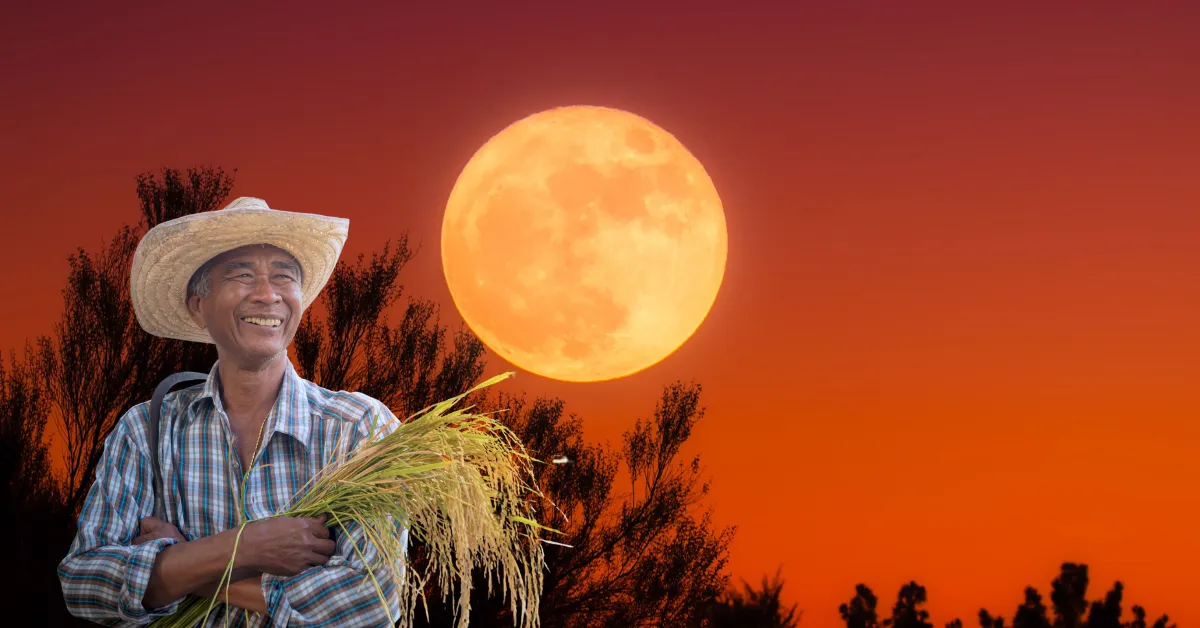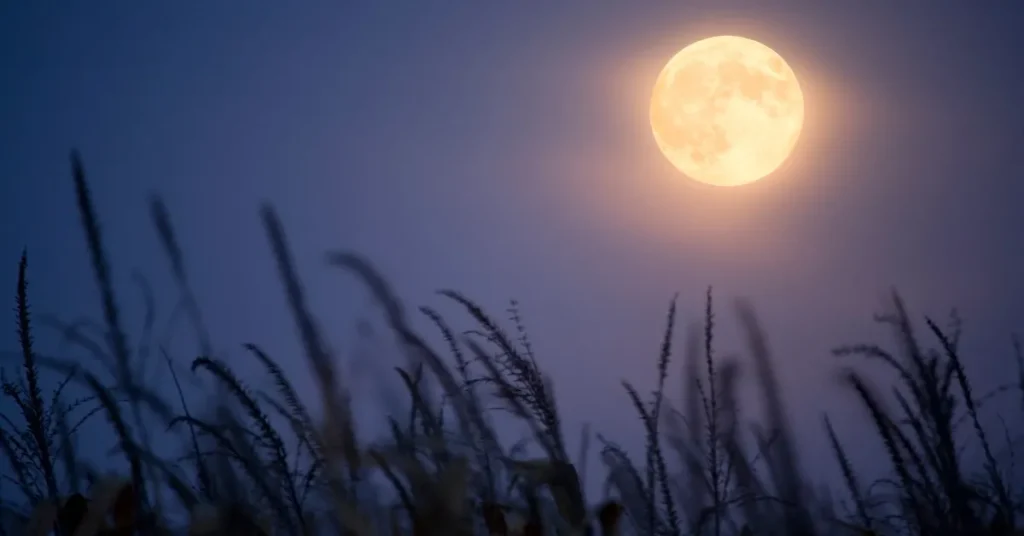Harvest Moon Harvest Sprites: Mythology, Folklore, and Festivals
The Harvest Moon is the full moon that occurs closest to the autumnal equinox, which is around September 22nd. It’s known for appearing fuller and brighter than other full moons and rises shortly after sunset, providing additional light. This was traditionally helpful for farmers who used the extended daylight to harvest their crops
In this article, we’ll explore the origins and attributes of harvest moon sprites, their roles in ancient seasonal rituals, and their lasting spiritual legacy.
Discover how harvest moons and sprites have inspired art, literature, festivals, and more throughout human history. Let’s unveil the magic of these enduring nature myths!

Table of Contents
What Is the Harvest Moon?
For centuries, cultures around the world have told tales of harvest sprites – magical nature spirits who emerge under the harvest moon to bless the land and bring good fortune.
The harvest moon is a popular fixture in the fall calendar, but few people know the fascinating mythology and folklore behind the celestial event.
Before diving into sprite lore, let’s cover some harvest moon basics.
- The harvest moon is the full moon closest to the autumnal equinox, which falls between September 22-23 in the Northern Hemisphere.
- It is named “harvest” because it rises closest to sunset, lighting up fields for farmers harvesting crops late into the evening.
- Its proximity to the horizon creates a glowing orange hue, attributed to the spirits of the harvest.
- Other names include the corn moon, barley moon, wine moon, singing moon, and mid-autumn festival moon.
- Cultures for centuries have celebrated the harvest moon with rituals for abundant crops and spiritual connection.
Now let’s explore the mythological creatures believed to emerge under its fertile glow.
Introducing Harvest Sprites
Harvest sprites are folkloric nature spirits with deep roots across European, Celtic, Slavic, and Scandinavian mythology. They are described as:
- Magical little creatures who personify the spirit of vegetation and the changing seasons.
- Manifesting as small, childlike humanoids or pixies, about the size of rodents.
- Closely tied to agriculture, fertility, and the harvest cycle.
- Guardians of nature, tasked with protecting trees, plants, and wildlife.
- Keepers of the sacred balance between humankind and the natural world.
According to folk legends, harvest sprites appear on the croplands every year in late summer and early autumn to ensure an abundant harvest. But where did these nature myths originate?
Origins and Early Cultural Beliefs
Harvest sprite mythology emerged in agrarian societies whose fate depended on successful seasonal crop growth.
- Ancient Europeans believed the harvest moon marked the one night of the year when sprites would emerge to work their magic.
- Celtic traditions described sprite tribes arriving on the first crescent harvest moon to bless the land.
- Germanic tales warned sprites would sabotage farms or spoil the harvest if they weren’t properly appeased.
- Slavic legend said harvest moon sprites gathered offerings left on fence posts to encourage fruitful harvests.
- Scandinavian folklore held that leaving gifts of milk, cakes, and honey for the sprites would grant blessings and protection.
Across cultures, harvest sprites took on important ceremonial roles. Let’s examine some of their rituals and festivities next.
Read More: Waning Crescent Moon Spiritual Meaning
Ancient Harvest Moon Rituals and Offerings

On the harvest moon, families and villages performed special rituals to welcome sprites and win their favor:
Harvest Shrines
Outdoor shrines were constructed on farmlands and decorated with fruits, vegetables, flowers, and offerings to the sprites.
Moonlit Feasts
Lavish feasts were held under the harvest moon, with place settings left for the invisible sprites.
Bonfires and Dances
Bonfires, chants, and dances mimicked the perceived activities of the sprites across the fields.
Milk and Honey
Bowls of milk and honey were left on nature altars and doorsteps for the sprites.
Nature Charms
Small nature charms, like acorn necklaces and cornhusk dolls, were crafted to protect properties from spiteful sprites.
Moonlit Walks
It was believed walking under the harvest moon allowed you to glimpse dancing sprites among the grain.
These rituals demonstrate the reverence, hope, and whimsy surrounding harvest moon sprite mythology. Centuries later, their magic continues to be felt.
Harvest Sprites in Literature and Art
The imagery of harvest sprites has profoundly inspired literature, music, and visual arts. Here are some notable examples:
- 19th century Romantic composers like Rimsky-Korsakov portrayed sprites in works like “Song of the Harvest Spirits.”
- Writers like Keats, Blake, and Shakespeare referenced harvest sprites to evoke the pastoral world.
- Fantasy authors like Tolkien adapted folkloric sprites into modern literature.
- Painters and illustrators like Arthur Rackham captured scenes of sprites emerging under the harvest moon.
- Brian Froud’s famous “fairy” art brought modern vitality to harvest sprite depictions.
- Animators like Studio Ghibli continue to incorporate harvest sprite themes and aesthetics.
Their small stature and whimsical nature have made harvest sprites particularly popular in children’s media and entertainment.
Modern Harvest Moon Holidays and Festivals
Many contemporary harvest festivals integrate historic harvest moon rituals and sprite symbolism:
Mid-Autumn Festival (Asia)
This Chinese festival centered around the harvest moon features mooncakes, lanterns, and moon worship.
Mabon (Paganism)
Mabon celebrates the autumn equinox with nature offerings, feasts, and altars to honor the sprite world.
Moon Festivals (Europe, Americas)
From the UK’s Blackpool Illuminations to Ontario’s Moon Festival, harvest moons are celebrated with fireworks and light displays.
Halloween (Global)
Halloween’s pagan origins incorporate harvest sprite themes, from children’s costumes to leaving offerings of candy.
Moon Viewing (Japan, Asia)
Tsukimi moon viewing festivals celebrate the beauty of the harvest moon while offering harvest foods and spirits gratitude.
Wine Festivals
The harvest moon’s link to winemaking is celebrated with grape stomps, tastings, and wine moon blessings.
The harvest moon clearly still inspires festivity today. But are the sprites themselves still alive in modern culture?
The Evolution of Harvest Sprite Symbolism
While belief in literal sprites has declined, their symbolic spirit endures:
- Representing our connection to nature’s cycles and role as environmental stewards.
- Reminding us to embrace wonder, creativity, and childlike joy.
- Capturing the magical glow that can be felt staring up at a harvest moon.
- Symbolizing the unseen realms and spirits that share our earth.
- Portraying our innate need to create meaning through myth and folklore.
Harvest sprites remain valued symbols during a symbolic time of gratitude, reflection, and childlike imagination.
FAQs About Harvest Moon Harvest Sprites
What offerings are best to leave for harvest sprites today?
Items like honey, milk, autumn flowers, moon or star-shaped cookies, garden fruits and vegetables, acorns, twigs, straw dolls, and harvest foods make thoughtful modern offerings.
When and where can you see real harvest sprites?
Harvest sprites exist today in mythology and symbolism, capturing the magic of nature and imagination. While some still believe in literal sprites, their existence is not proven.
Do harvest sprites have different names across cultures?
Yes, similar sprite myths go by names like faeries, fae folk, pixies, pookas, wee folk, small folk, little people, brownies, and more depending on the region and culture.
Is it possible to photograph real harvest sprites?
While people continue trying to capture photographic evidence of sprites, none have been definitively proven authentic. Blurs are often normal insects, dust, or optical illusions. The true sprites remain elusive.
Do harvest sprites only appear in fields and farms?
Traditionally linked to croplands, lore often describes sprites inhabiting gardens, orchards, meadows, woodlands, misty hills, forest glens, and other natural places.
Final Words
For millennia, the enchanting harvest moon has awakened awe, hope, and mythic sprites in the human psyche. While magic evolves with culture, the harvest moon still awakens our sense of wonder and connection today.
So as you gaze up at the next harvest moon, open your heart and mind to the possibility of magic. Listen for the distant songs of the sprites. Wink back at the twinkling lunar light. Breathe in the crisp night air, crackling with potential.
Who knows – if you believe, you just might feel some sprite magic that night!
Reference:
https://www.britannica.com/topic/harvest-moon-full-moon
